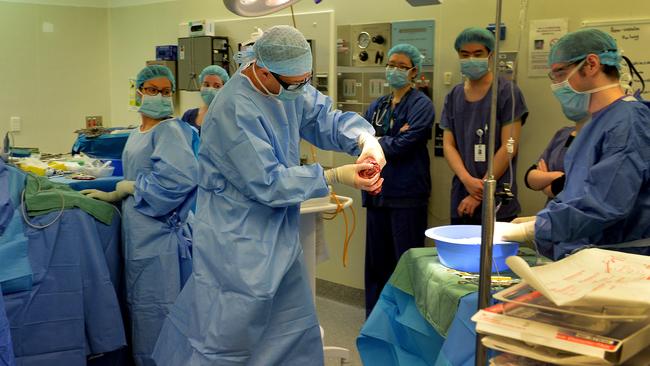World-first kidney transplant exercise that saved six lives could be the first of many
THE country’s largest paired kidney exchange that saved six lives and inspired millions came close to being thwarted with a lump on a recipient’s leg.

VIC News
Don't miss out on the headlines from VIC News. Followed categories will be added to My News.
THE country’s largest paired kidney exchange saved six lives, but enriched so many more.
For a father and son it will mean their first holiday in 14 years.
It’s the chance for a husband and wife to celebrate a 50th wedding anniversary.
And for a single mother, she will soon play with her toddler without getting puffed.
It has been almost three weeks since more than 200 Victorian medical staff united to perform 12 almost simultaneous operations.
MORE: Six saved in extraordinary world first
Six people donated a kidney so half a dozen others could receive a lifesaving transplant.
The feat showcased incredible dedication and skill, from the scientists who found the matches to the transplant surgeons and the countless doctors and nurses who continued to care for the patients long after the last stitches were sewn.
But while it showed the power of many people working together, it also highlighted the impact of just one person.
For without a single altruistic live kidney donor, the missing link in the chain of life that allowed the other matches to be made, none of it would have been possible.
Although they were the state’s first donor of this kind, Australian Paired Kidney Exchange Program director Dr Paolo Ferrari says they were unlikely to be the last.
The Organ and Tissue Authority program has enabled 92 transplants to occur, but this could be far higher if the pool of potential matches was larger.

“I’m confident that in the near future we will see more people come forward and helping people in need,” he says.
While it is still early days in their recovery, all but one of the 12 patients has been discharged from hospital.
But today the Sunday Herald Sun can now reveal how a lump on a leg came close to thwarting all the surgeries.
Less than two days before the medical marathon, transplant recipient Grant Lenan, 51, found a mystery mound.
Royal Melbourne Hospital Nephrology Director Professor Steve Holt said they couldn’t rule out cancer.
“Right until the last minute we were paranoid about the health and welfare of all our recipients and donors; had any one of them pulled out the whole chain would have fallen apart.”
After a sleepless night, the biopsy results came back — the growth was a complication of Mr Lenan’s kidney failure.
Sighs of relief reverberated across the four hospitals.

Mr Lenan was prepped for a transplant, his second surgery of this kind.
The first kidney was a gift from his mother in 1999, which not only saved his life, it gave him the chance to have a son.
But kidneys are like cars, they don’t run forever.
About 14 months ago Mr Lenan went back on dialysis after disease destroyed the donor organ.
Like most of the 11,000 Australians on dialysis he has spent much of his life in hospital, so much so that he has used almost all his annual leave for the past 14 years as sick leave.
“This is my holiday camp,” he says, smiling, and looking around the Parkville hospital as if it were the Park Hyatt.
All that will change now that he has a new kidney. He is already planning his first father and son holiday.
Husband and wife Robert and Patricia Macdermid also want a break, but not from each other.
After more than 40 years of marriage, Mrs Macdermid didn’t hesitate in offering her organ to her husband.
“For 40 years he was a wonderful husband, a wonderful provider and a very good father,” she says.
But as the toxins built up in his body his physical and mental health withered, until he could not make it from the house to the letterbox.
Like many couples, the pair’s kidneys were incompatible. A paired exchange was their only hope.
Dr Ferrari said finding compatible pairs with their computer program was a bit like using a dating agency.
All the preferences: in this case: blood, tissue and antibody levels are fed into the machine; but it takes tireless human testing to confirm the perfect match.
Finally the Macdermid’s found theirs.
So too had young mother Brylie Vines, but only if mum Leanne would give up her kidney. Why wouldn’t she give her daughter and grandson a chance at a better life?
Last week the pair were hobbling around their house together still surgery sore.
Soon though, Miss Vines will have the energy to keep up with her baby Cooper, and Leanne will be powering away on one kidney.
Like the other donors she will never know exactly who got her organ, but it matters little; for the loss of an kidney is far outweighed by the gain of a loved one’s life.
As for the altruistic donor, they are unlikely to ever grace the pages of print, but their private reward is knowing that their single selfless act has had a profound impact on the lives of so many.


